Microfiber Beach Towel: Complete Guide 2025
Microfiber Beach Towel vs Cotton Towel: Quick Comparison
| Attribute | Microfiber Towel | Cotton Towel |
|---|---|---|
| Absorbency | High (absorbs 7x its weight) | Moderate (absorbs but slower) |
| Drying Time | Very fast (2-3 hours) | Slow (6-10+ hours) |
| Weight | Lightweight (200-400g) | Heavier (500-900g) |
| Bulkiness | Compact and thin | Bulkier |
| Sand Resistance | Resistant (sand shakes off easily) | Sand sticks and embeds |
| Durability | Long-lasting synthetic blend | Cotton can wear out faster |
| Care Requirements | Wash with mild detergent, no fabric softener | More flexible but can shrink |
🌊 Why Choose a Microfiber Beach Towel?
- Super absorbent: Soaks up water 7 times its own weight
- Quick-drying: Dries 3 times faster than cotton towels
- Sand-free: Sand shakes off easily without sticking to fibers
- Lightweight & compact: Perfect for travel, gym, and outdoor activities
- Durable: Lasts longer with proper care compared to traditional towels
Have you ever struggled with a heavy, wet beach towel that refuses to dry? Or maybe you’ve spent countless minutes trying to shake sand out of your cotton towel? If so, then a microfiber beach towel might be exactly what you need. Moreover, these modern towels are changing the way people enjoy beach days, pool parties, and outdoor adventures.
In this complete guide, you’ll discover everything about microfiber beach towels. From their special features to how to choose the perfect one for your needs, we’ve got you covered. Additionally, we’ll share expert tips on care and maintenance to help your towel last for years.
What Is a Microfiber Beach Towel?
A microfiber beach towel is made from tiny synthetic fibers that are much thinner than human hair. In fact, these fibers are so small that they’re called “micro” fibers. Specifically, the material is usually a blend of polyester and polyamide (also known as nylon).
To help you understand better, imagine a single strand of human hair. Now, picture a fiber that’s about 100 times thinner than that hair. That’s how fine microfiber is! Because these fibers are so tiny, they can be woven together very tightly. As a result, this creates a fabric with amazing properties.
Unlike traditional cotton towels that have thick, fluffy loops, microfiber towels have a smooth, flat surface. Furthermore, this special construction gives microfiber beach towels their unique abilities. Therefore, they can absorb more water while staying lightweight and compact.

Vibrant microfiber beach towels in various colors and designs
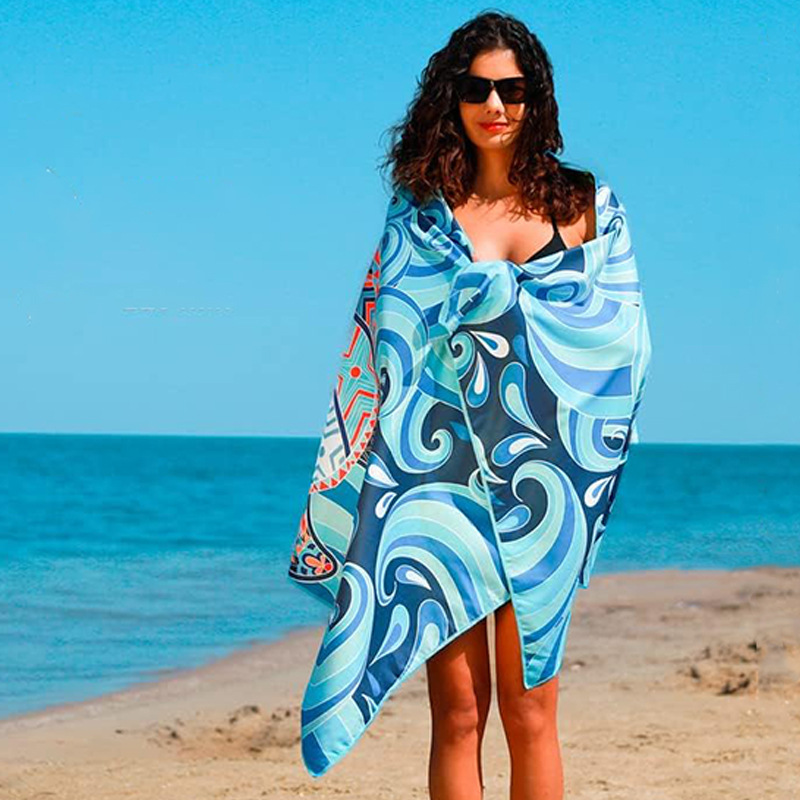
Lightweight and compact design perfect for travel
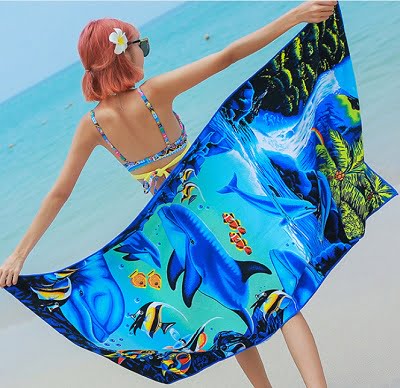
Custom printed microfiber beach towel with dolphin design
“Microfiber technology has revolutionized beach towels by creating a material that’s both highly absorbent and incredibly quick-drying. It’s science working for your comfort!”
Why Microfiber Beach Towels Beat Cotton Towels (Key Features)
Now that you know what a microfiber beach towel is, let’s explore why it’s better than traditional cotton towels. In addition to being modern and stylish, these towels offer real, practical benefits that make beach days more enjoyable.
Super Absorbency – Holds 7X Its Weight
One of the most impressive features of a microfiber beach towel is its incredible absorbency. Surprisingly, these thin towels can absorb up to seven times their own weight in water! In comparison, cotton towels typically absorb only about five times their weight.
But how does this work? Well, the tiny microfibers create millions of small spaces between them. Consequently, these spaces trap and hold water very effectively. Therefore, you can dry off completely with just one or two wipes. As a result, you’ll feel dry and comfortable much faster than with a cotton towel.
Quick-Dry Technology – Dries 3X Faster
Nobody likes using a damp, smelly towel for their second swim of the day. Fortunately, microfiber beach towels solve this problem completely. Because of their synthetic material and thin design, they dry incredibly fast. In fact, they typically dry about three times faster than cotton towels.
For example, a wet microfiber beach towel hanging in the sun will usually be completely dry in 2-3 hours. On the other hand, a cotton towel might take 6-10 hours or even longer. Moreover, this quick-drying feature prevents mildew and bad odors from developing. Therefore, your towel stays fresh and clean throughout your beach trip.
Lightweight and Compact – Perfect for Travel
Have you ever packed for a beach vacation and struggled to fit bulky towels in your suitcase? If so, you’ll love how lightweight microfiber beach towels are. Specifically, they weigh about 50-70% less than cotton towels of the same size.
Additionally, these towels can be folded or rolled into incredibly small packages. In fact, many come with a convenient mesh carrying bag that fits easily in your backpack. As a result, they’re perfect for travelers, campers, and anyone who likes to stay active on the go.

Convenient mesh bag for easy storage and transport
Sand Resistance – Shake and Go
Here’s perhaps the best feature of all: sand doesn’t stick to microfiber beach towels! Unlike cotton towels where sand embeds deep into the fluffy fibers, sand simply sits on the smooth surface of microfiber. Therefore, a quick shake is all you need to remove it completely.
This sand-resistant property is a game-changer for beach lovers. Because of this feature, you won’t track sand into your car, hotel room, or home. Furthermore, your towel stays cleaner and requires less washing. Consequently, it lasts longer and maintains its quality over time.
Long-Lasting Durability
When you invest in a quality microfiber beach towel, you’re buying something that will last for years. Since the synthetic fibers are extremely strong, they resist tearing and fraying. Moreover, the colors stay bright and vibrant even after many washes.
According to Consumer Reports, well-made microfiber products can outlast their cotton equivalents by several years. In addition, they maintain their absorbency and softness much longer than cotton towels. Therefore, while microfiber beach towels might cost slightly more upfront, they offer better value over time.
Microfiber Beach Towel Fabric and GSM Explained
When shopping for a microfiber beach towel, you’ll often see the term “GSM” mentioned. But what does this mean? And why should you care? Let’s break it down in simple terms.
Understanding GSM (Grams Per Square Meter)
GSM stands for “grams per square meter.” Basically, it measures how much the fabric weighs. Specifically, it tells you how dense and thick the towel material is. Therefore, a higher GSM number means a heavier, thicker towel. Conversely, a lower GSM number means a lighter, thinner towel.
Here’s a helpful breakdown of different GSM ranges:
- 200-250 GSM: Ultra-lightweight and super compact. Perfect for backpackers and minimalist travelers who want the smallest possible towel.
- 250-350 GSM: The most popular choice for beach towels. This range offers an excellent balance of absorbency, quick-drying, and portability.
- 350-450 GSM: Thicker and more plush. Better for people who prefer a more substantial feel, though they dry slightly slower.
- 450+ GSM: Maximum absorbency and softness. However, these are heavier and take longer to dry.
For most beach activities, a microfiber beach towel in the 280-320 GSM range works perfectly. In addition, this weight range provides great absorbency while still maintaining quick-drying properties. Moreover, it stays lightweight enough for easy carrying and packing.
Polyester vs Polyamide Blend Breakdown
As mentioned earlier, microfiber beach towels are made from synthetic fibers. Typically, they contain a blend of polyester and polyamide (nylon). However, the exact ratio of these materials affects the towel’s performance.
Most quality microfiber beach towels use an 80/20 blend. Specifically, this means 80% polyester and 20% polyamide. Here’s why this combination works so well:
- Polyester: Provides durability, quick-drying properties, and color retention. Additionally, it’s resistant to shrinking and stretching.
- Polyamide: Adds extra absorbency and softness. Furthermore, it helps the towel feel smoother against your skin.
When shopping at Favor Houseware, you’ll find towels made with premium synthetic blends. Moreover, these high-quality materials ensure your towel performs well for years. Therefore, investing in a well-made microfiber beach towel from a trusted manufacturer with 15 years of experience pays off in the long run.
How to Choose the Right Microfiber Beach Towel
With so many options available, choosing the perfect microfiber beach towel can feel overwhelming. However, by considering a few key factors, you can find exactly what you need. Let’s walk through the important things to think about.
Size Guide (With Actual Measurements)
Microfiber beach towels come in several standard sizes. Here’s what you need to know about each one:
- Standard Size (30 x 60 inches): Perfect for one person. Additionally, this size is easy to pack and carry. Therefore, it’s ideal for solo travelers and gym-goers.
- Large Size (35 x 63 inches): Offers more coverage without being too bulky. Furthermore, this size works well for taller people who need extra length.
- Oversized/XL (40 x 70+ inches): Provides maximum comfort for lounging. Moreover, families can share this size. Consequently, it’s great for beach picnics and sunbathing.
When choosing a size, consider how you’ll use your towel most often. For example, if you’re mainly using it for quick drying after swimming, a standard size works great. On the other hand, if you like to lay out and sunbathe, an oversized option might be better.
GSM Selection Based on Use
Remember that GSM number we discussed earlier? Now it’s time to pick the right one for your needs. Here’s a simple guide:
- For backpacking and hiking: Choose 200-250 GSM for minimal weight and maximum packability.
- For regular beach use: Select 280-320 GSM for the best balance of all features.
- For home or poolside: Consider 350-400 GSM if you prefer a thicker, more luxurious feel.
Additionally, think about your local climate. In hot, sunny areas, towels dry faster naturally. Therefore, you might prefer a slightly higher GSM. Conversely, in humid climates, a lower GSM ensures quicker drying.
Color and Design Considerations
While functionality is important, style matters too! Fortunately, microfiber beach towels come in countless colors and patterns. Moreover, many manufacturers offer custom designs and personalization options.
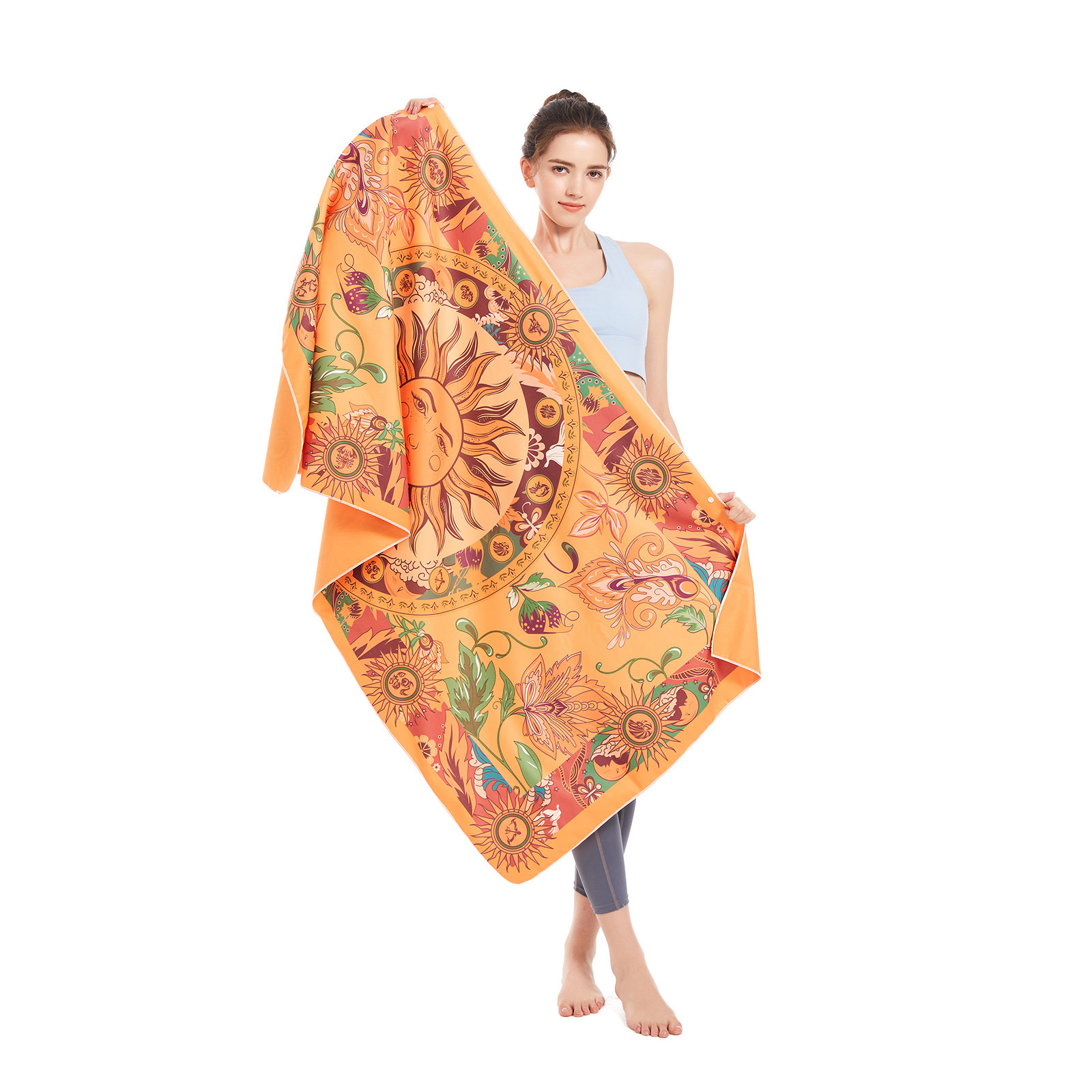
Modern geometric patterns and bold colors
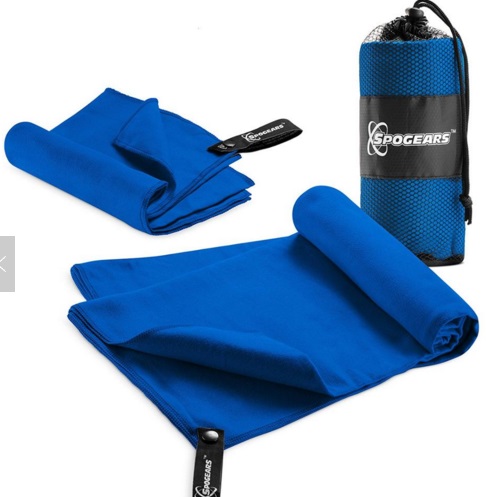
Tropical themed microfiber beach towels
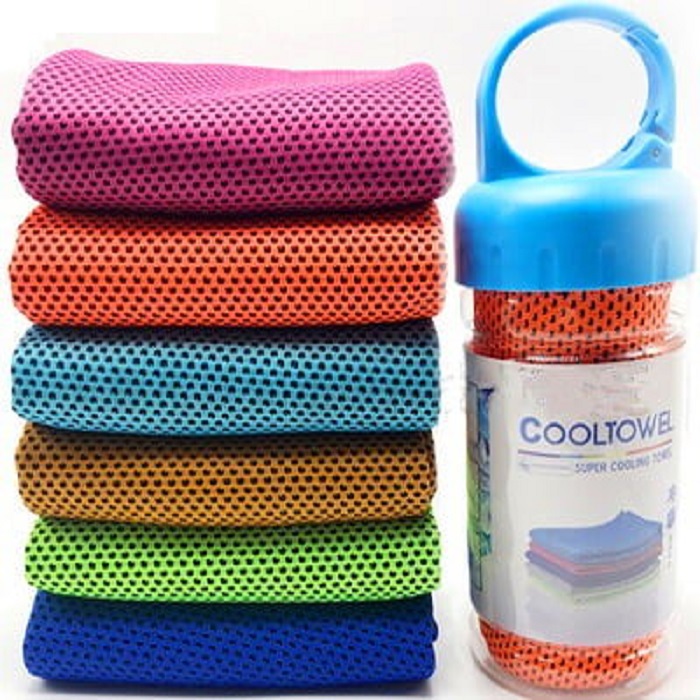
Microfiber cooling sports towel for active use
When selecting colors, keep these tips in mind:
- Dark colors: Hide stains better but may fade faster in intense sunlight.
- Light colors: Stay cooler in the sun and show less fading over time.
- Bright patterns: Easy to spot on crowded beaches and fun for kids.
Price Range Guidance
Generally, microfiber beach towels range from $15 to $45 for retail purchases. However, the price varies based on several factors:
- Budget options ($15-$22): Basic designs with lower GSM. Good for occasional use or as backup towels.
- Mid-range ($23-$35): Better quality materials with good durability. Perfect for regular beach-goers and travelers.
- Premium ($36-$45+): Highest quality materials, custom designs, and best durability. Ideal if you use your towel frequently.
For businesses or bulk purchases, working directly with manufacturers like Favor Houseware offers significant savings. Additionally, with minimum order quantities starting at just 100 pieces, even small businesses can access wholesale pricing.
Microfiber Beach Towel Uses Beyond the Beach
While they’re called “beach towels,” these versatile accessories work great in many situations. In fact, once you experience the benefits of a microfiber beach towel, you’ll probably want to use it everywhere! Let’s explore the various ways you can use your microfiber towel.
Pool and Water Sports
Microfiber beach towels are perfect for swimming pools and water sports. Because they resist chlorine damage better than cotton, they last longer in pool environments. Moreover, their quick-drying nature means you can take multiple swims without dealing with a soggy towel.
For surfers, paddleboarders, and kayakers, these towels are especially useful. Specifically, they pack small enough to fit in waterproof bags. Additionally, they won’t weigh down your gear. Therefore, athletes love using microfiber towels for water sports and outdoor adventures.
Gym and Fitness
Many fitness enthusiasts have discovered that microfiber beach towels make excellent gym towels. Since they absorb sweat effectively and dry quickly, they stay fresher between uses. Furthermore, they take up minimal space in gym bags.
Consider this: after an intense workout, your cotton towel might stay damp for hours. In contrast, a microfiber beach towel will be mostly dry by the time you get home. As a result, your gym bag won’t develop that unpleasant musty smell. Additionally, you can check out cooling sports towels specifically designed for athletic activities.
Travel and Camping
For travelers and campers, microfiber beach towels are nearly essential. Their lightweight, compact design makes them perfect for backpacking trips where every ounce matters. Moreover, they dry quickly even in humid conditions or when hung inside a tent.
Many hostels and camping sites don’t provide towels. Therefore, having your own compact microfiber towel ensures you’re always prepared. Furthermore, some travelers pack multiple microfiber towels in different sizes. For instance, one for showering, one for the beach, and one for wiping down gear.
Yoga and Outdoor Activities
Yoga practitioners love using microfiber towels on their mats. Specifically, the non-slip surface helps prevent sliding during poses. Additionally, the towels absorb sweat during hot yoga sessions. Consequently, your practice stays comfortable and safe.
Beyond yoga, microfiber beach towels work wonderfully for picnics, hiking, and general outdoor activities. Because they’re easy to clean and sand-resistant, they make great ground covers. Moreover, they fold up small enough to carry on any adventure.
How to Care for Your Microfiber Beach Towel
Proper care is essential for keeping your microfiber beach towel in top condition. Fortunately, caring for these towels is quite simple. However, there are some important do’s and don’ts to remember. Follow these guidelines to ensure your towel lasts for years.
Washing Instructions (Step-by-Step)
Before First Use: Always wash your new microfiber beach towel before using it. This removes any manufacturing residue and maximizes absorbency. Additionally, it ensures the towel is clean and fresh for your first use.
Regular Washing Process:
- Check the care label: First, always read the manufacturer’s specific instructions.
- Shake out debris: Before washing, shake your towel outdoors to remove sand, dirt, or loose particles.
- Use cold or warm water: Never use hot water, as it can damage the synthetic fibers.
- Choose mild detergent: Select a gentle, liquid detergent without harsh chemicals.
- Load the washer properly: Don’t overload the machine. Additionally, wash microfiber towels separately from cotton items to prevent lint transfer.
- Select gentle cycle: Use a delicate or normal wash cycle to minimize wear on the fibers.
According to experts at Good Housekeeping, proper washing techniques can significantly extend the life of microfiber products. Therefore, following these steps is worth the extra effort.
Drying Tips
Drying your microfiber beach towel correctly is just as important as washing it properly. Here are the best methods:
Air Drying (Best Method): Hang your towel in a well-ventilated area or outdoors. Because microfiber dries so quickly, most towels will be completely dry within 2-4 hours. Furthermore, air drying uses no energy and causes zero wear on the fibers.
Machine Drying (When Necessary): If you must use a dryer, follow these rules:
- Use the lowest heat setting or air-dry/no-heat option
- Remove the towel promptly when dry to prevent over-drying
- Never use high heat, as it can melt or damage synthetic fibers
What to Avoid (Fabric Softener, High Heat)
These common laundry products and practices will ruin your microfiber beach towel. Therefore, avoid them completely:
- Fabric softeners: These coat the microfibers and destroy their absorbency. Once coated, the towel won’t absorb water properly anymore.
- Dryer sheets: Like fabric softener, these leave a waxy residue that reduces absorbency.
- Bleach: Harsh chemicals break down synthetic fibers and cause premature wear.
- High heat: Excessive heat can melt polyester fibers, causing permanent damage.
- Ironing: Never iron a microfiber towel, as the heat will melt the synthetic material.
“The number one mistake people make with microfiber towels is using fabric softener. This single error can ruin an otherwise perfect towel by coating the fibers and blocking their absorbent properties.”
Storage Recommendations
Storing your microfiber beach towel properly helps maintain its quality between uses. Here’s what to do:
- Ensure complete dryness: Never store a damp towel, as this encourages mildew and odors.
- Fold or roll neatly: This prevents creases and maintains the fabric structure.
- Use breathable storage: Store in a cool, dry place with good air circulation. Avoid plastic bags for long-term storage.
- Keep away from heat sources: Don’t store near radiators or in hot areas like car trunks during summer.
If your towel came with a mesh carrying pouch, this makes perfect storage. Alternatively, a drawer or linen closet works well. Most importantly, ensure the storage area is dry and well-ventilated.
Custom Microfiber Beach Towels – Personalization Options
One of the exciting features of modern microfiber beach towels is the ability to customize them. Whether you’re a business owner, event planner, or someone looking for unique gifts, custom towels offer fantastic possibilities. Let’s explore your personalization options.
Digital Printing (No MOQ)
Digital printing technology has revolutionized custom towel production. Unlike old methods that required large minimum orders, modern digital printing allows for small batch production. In fact, some manufacturers now offer custom printing with no minimum order quantity (MOQ).
This means you can order even a single custom towel if needed! However, most businesses find that ordering 100-500 pieces offers the best value. Additionally, digital printing produces vibrant, detailed images that won’t fade quickly. Therefore, your custom design stays beautiful wash after wash.
The process is straightforward. First, you provide your design or logo. Then, the manufacturer prints it directly onto the microfiber fabric using specialized printers. Finally, the towel is finished with proper hemming and quality checks. Consequently, you receive a professional product ready for use or resale.
Sublimation Printing Capabilities
Sublimation printing is another excellent option for microfiber beach towels. This technique works especially well with polyester-based fabrics. Basically, the ink becomes part of the fabric rather than sitting on top of it. As a result, the design feels smooth and won’t crack or peel over time.
Because microfiber towels typically contain 80% polyester, they’re perfect for sublimation printing. Moreover, this method allows for full-color, photo-quality images. Therefore, you can create towels with complex designs, gradients, and detailed artwork.
According to Printing Impressions, sublimation printing on poly
